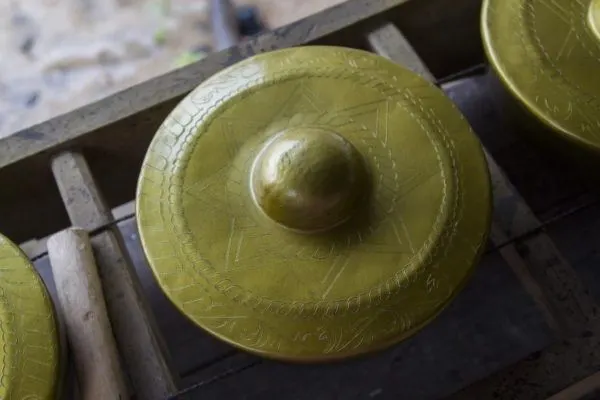Kampung Sumangkap and Kampung Gombizau are two of the Handicraft Villages of Kudat. Remote and traditional, these two villages make for an interesting day trip out of Kota Kinabalu.
Towards the end of our Borneo trip after gawking at proboscis monkeys and orangutans, we were back in the capital city of Kota Kinabalu with some time to spare. We were searching for someplace to go to do something different, and finally we found a destination, and it was definitely offbeat.
We decided to drive up the peninsula to the famous handicraft villages that followed the “One Village, One Product” guidelines developed in 2003. In most Asian countries, and even in Malaysia, different streets are dedicated to different products. This just takes the concept a little further, and there are product towns.
The main premise of this is to increase revenues in rural areas and, for at least a couple of places, it seems to be working. There were two villages we wanted to visit in particular, the gong village and the bee hive village.

Malaysian Handicrafts and Honey
We gassed up before we left so that there wouldn’t be a repeat of our harrowing experience on the way to Sandakan after leaving Mt. Kinabalu. About two hours up the road where thankfully we didn’t see any palm oil plantations, we turned off onto a narrow road that surprisingly was paved.
We came to the first town and on the right side of the road stood a small booth to collect the fee. Ingeniously the townspeople collect 5 RM per person to visit their village. You are welcome to wander around, take photos, and talk to the residents as they go about their daily lives.

Throughout my travels, I’ve come across a few villages like this and I think it’s a pretty good practice. As a tourist, it lets you do what you came to do and the villagers get something out of it, too, without demanding money each time you take photo.

The gong village is called Kampung Sumangkap. We parked our car, paid our fee, and walked in to the tiny neighborhood. Malaysians use the gongs on many occasions–for example, after we saw the Rafflesia we banged a gong.
The villagers were making gongs of all sizes, but they all looked extremely similar, a round shape with various rings, culminating in a point. On both sides of the road were small stilted houses with covered workshops next door.
On the shelves were gongs in all states of preparation, and finished gongs hung from the walls ready to be sold. We were there on a Sunday so most people were not in their workshops. We had a pleasant time wandering around; admiring the gong makers’ handiwork, but it was a bit disappointing not seeing any work going on.

Kampung Gombizau , the honey bee farm village is only a couple of kilometers up the road. We were ready to stop, register and pay our fee, but something else happened.
Curiously, the lady asked us if we would like to see the bee hives. Well, yes, that’s why we came. There was a stand selling honey from the village and a few beaded trinkets, but really we were there to see the honey making process.

Our self-appointed “guide” proceeded to parade us through the village without saying one word. She stopped at the toilets and asked if we needed to use it, but then took us into a stand of trees with weather-battered wooden beehives among them.
As it turned out, she didn’t really speak English and of course my Malay is non-existent, so we waited. Soon another woman came up and she was carrying a bee smoker. The first woman smoked the hive we were nearest to, and pulled out a bottom board with plenty of honey stuck to the screen, and plenty of bees accompanying it, to the outside.
She then handed the board to me to hold and take a closer look. I took it, even though I had no protective clothing. She hadn’t had any, so I figured it would be okay. Then Jim held it, inspecting the bees and honey.
Devon refused to take it, and guess who was the only one to be stung that day…ironic? Afterwards, we walked back through the village, bought some honey, and left.

Honestly, the visit to these two villages was lackluster at best. I think the program, “One village, one product” is basically working, but only because the villages have become tourist spots. However, they are not doing much. In the gong village, they supposedly do performances for groups but we not only didn’t see any evidence of that, we only saw one person working on any gongs.

I realize it was Sunday, and we were not on a tour, but neither village seemed set up for any real tourist interaction which I think would make it a much more desirable destination. I would not recommend going to either village on a tour or on your own. The experience was just so-so. I didn’t learn anything at either place and to me (maybe because I’m a teacher) that is the value in going to a place like this.

Have you ever been to one of these handicraft villages? Did you go on a tour or on your own? What was your experience, and would you recommend it to future travelers?
Author Bio: Corinne Vail is a travel photographer, food lover, and a perpetual traveler who has been travel writing for over 14 years. For many years she lived overseas in Germany, Japan, Turkey, South Korea, and the Netherlands teaching the children of the US. military. She’s visited over 90 countries, and she’s not stopping anytime soon.









Carrie
Monday 3rd of March 2014
This was one of my favorite places in Kota Kinabalu when we visited in 2010. It was raining that day, but the villagers still came out to show us how they make their gongs. I hope you had a chance to travel a little further to view the Tip of Borneo. It's a beautiful place!
Corinne Vail
Monday 3rd of March 2014
Carrie, It was raining the day we were there as well. We didn't make it to the tip unfortunately! Thanks for your comment.
Mary {The World Is A Book}
Friday 28th of February 2014
I have never visited a handicraft village and it's interesting to hear about the "One Village, One Product" concept. It's too bad they didn't really do anything to educate you on your visit to their villages. I would have been too scared to go anywhere near a beehive.
Corinne Vail
Saturday 1st of March 2014
Mary, To be honest it seems like the same type of thing that happens anytime a group or town receive a grant. The program was instituted, but I didn't really get the feeling that the townspeople were all on board. I don't know if they are reaping any of the benefits. It was an odd feeling, a missed opportunity on their parts. I think if they really wanted to attract more people to buy their products, they need to work a little harder at providing some type of experience more than just buying the products and holding the bees.
Stanly P Lester
Thursday 27th of February 2014
Having just discovered your site, I am now an admirer and enthusiast.
SPL
Corinne Vail
Thursday 27th of February 2014
Thanks Pat!